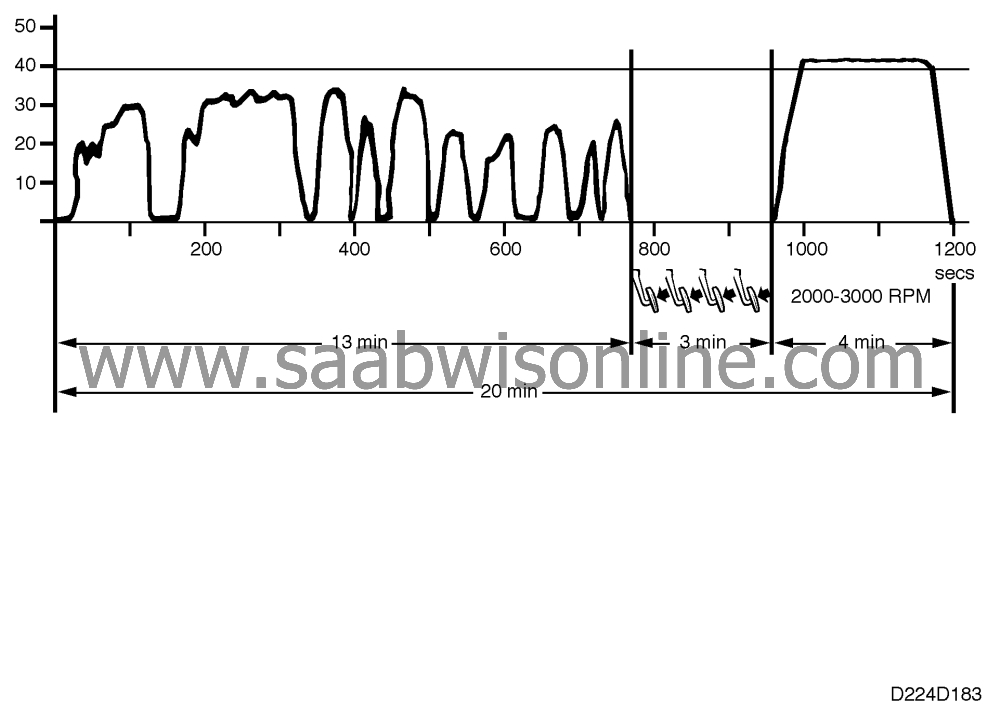Driving a trip
| Driving a trip |
Fault diagnosis described in the service manual always ends with a final check.
The final check includes a driving cycle that is specific for each type of rectified fault.
The driving cycle ensures that On-Board Diagnostic II is performed for the function in question.
Any remaining fault will subsequently be revealed on DTC readout.
After an individual fault has been rectified, a check is made in this way to confirm that the fault really has been rectified.
A trip entails driving in such a way that all components and functions embraced by On- Board Diagnostic II are monitored.
After a very extensive repair involving a large number of emission-related components or functions, such as when the power train has been removed, a trip may well be warranted. Any faults can be revealed afterwards by requesting a DTC readout.
When a trip has been made, all conditions for On-Board Diagnostic II have been fulfilled one by one in the right order.
The time it takes to complete a trip will mainly depend on the following factors:
| • |
traffic conditions
|
|
| • |
driving style
|
|
| • |
engine management system version
|
|
| • |
any faults detected
|
|
| • |
climate (affects A/C and radiator fan engagement, which may disturb a certain
diagnosis). Since the various possible combinations of the above factors are infinite in
number, the time it takes to complete a trip may vary widely. The following example of a trip is
therefore only valid if the following conditions are fulfilled:
|
|
| • |
choice of traffic conditions according to driving profile
|
|
| • |
driving according to driving profile
|
|
| • |
Trionic M96-
|
|
| • |
A/C disengaged and radiator fan engaged continuously for a certain
time
|
|
| • |
only 1 fault can be detected with certainty.
|
|
| 1. |
Clear any diagnostic
trouble codes and unplug the temperature sensor connector from the ICE so that the radiator
fan will run continuously during the trip.

|
|
| 2. |
Diagnosis of the majority of components and functions except: front heated
oxygen sensor, evaporative emission system and three way catalytic
converter.
|
|
| • |
Driving in town traffic for such a
length of time that vehicle speed exceeds 0 km/h for a total of 10 minutes.
|
|
| • |
braking at least 6 times from >40 km/h to 0 km/h
|
|
| • |
Diagnosis of the front heated oxygen sensor and evaporative emission
system
|
|
| • |
Stop the car, run the engine at idling speed and proceed as
follows:
|
|
| • |
select Neutral (or Park) and apply the handbrake
|
|
| • |
turn off the A/C (ACC: select ECON)
|
|
| • |
do nothing to affect engine load (power steering, electrical equipment,
etc.).
|
|
| • |
depress the accelerator a second or two and then run the engine at idling speed
for 30 seconds. Repeat three times
|
|
| • |
Diagnosis of three way catalytic converter:
|
|
| • |
driving with steady throttle at 40-90 km/h for 4 minutes
|
|
| • |
select a gear so that engine speed is 2000-3000 rpm
|
|
| • |
throttle position changes should be avoided, so as level a road as possible
should be chosen
|
|
| • |
Final check
|
|
| • |
Check whether any diagnostic trouble code has been generated and take
remedial action as necessary
|
|
| • |
Connect the temperature sensor to the ICE
|
|
| • |
Clear the diagnostic trouble code for the ICE temperature sensor
|
|


